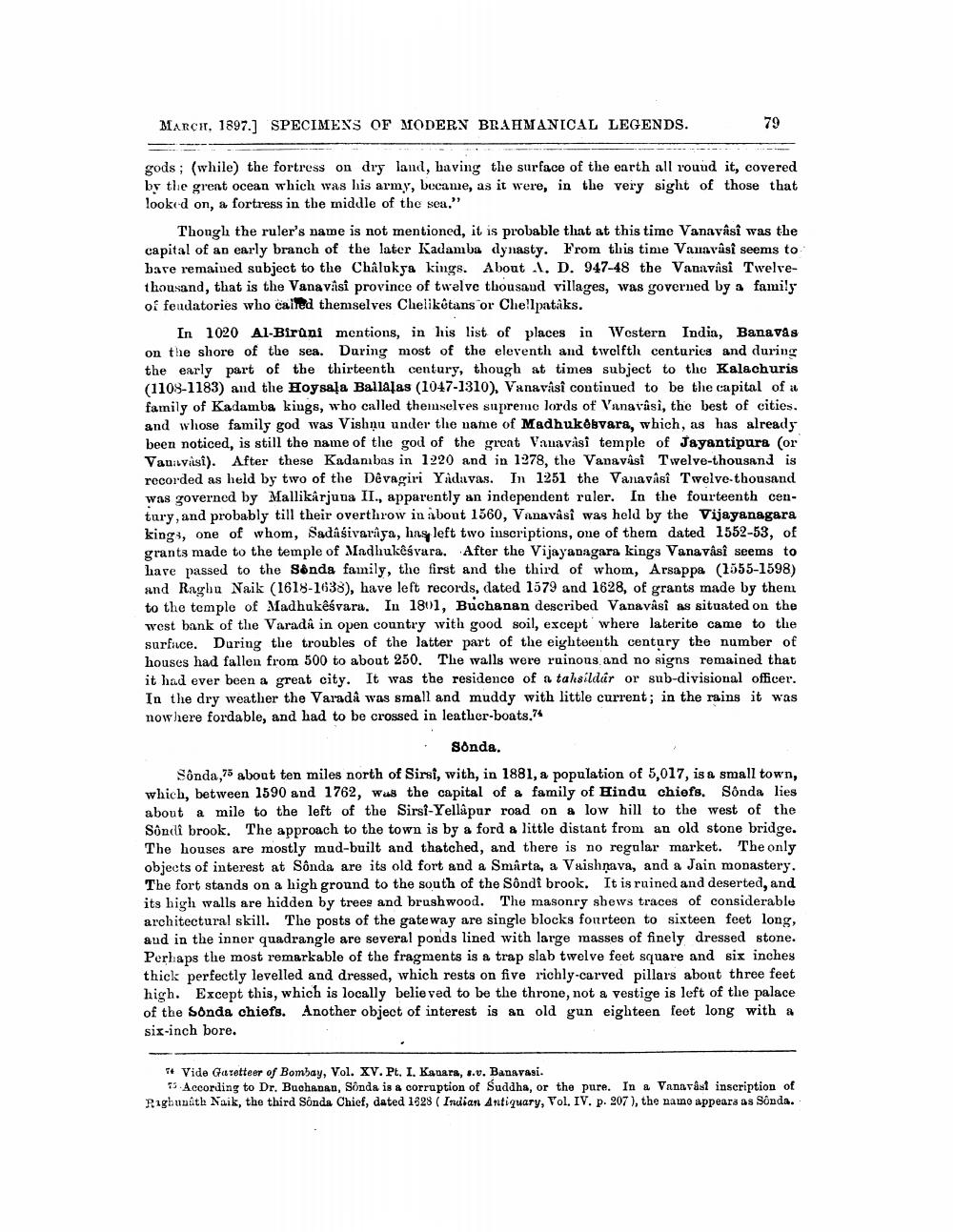________________
Marca, 1897.] SPECIMEXS OF MODERN BRAHMANICAL LEGENDS.
79
gods; (while, the fortress on dry land, having the surface of the earth all round it, covered by the great ocean which was his army, became, as it were, in the very sight of those that looked on, a fortress in the middle of the sea."
Though the ruler's name is not mentioned, it is probable that at this time Vanavâsî was the capital of an early branch of the later Kadamba dynasty. From this time Vanavasi seems to bare remained subject to the Châlokya kings. About 1. D. 947-48 the Vannvisi Twelvethousand, that is the Vanavasi province of twelve thousaud villages, was governed by a family of feudatories who cailed themselves Chelikótans or Chellpatiks.
In 1020 Al-Biruni mentions, in his list of places in Western India, Banavas on the shore of the sea. During most of the eleventh and twelfth centuries and during the early part of the thirteenth century, though at times subject to the Kalachuris (1108-1183) and the Hoysaļa Ballalas (1047-1310), Vanavisi continued to be the capital of at family of Kadamba kings, who called themselves supremo lords of Vanavasi, the best of cities. and whose family god was Vishnu under the name of Madhukekvara, which, as has already been noticed, is still the name of the god of the great Vauavasi temple of Jayantipura (or Van: visi). After these Kadanıbas in 1220 and in 1278, the Vanavisi Twelve-thousand is recorded as held by two of the Dêvagiri Yadavas. In 1251 the Vanavasi Twelve-thousand was governed by Mallikarjuna II., apparently an independent ruler. In the fourteenth century, and probably till their overthrow in about 1560, Vanavasi was held by the Vijayanagara kings, one of whom, Sadasivaraya, has left two inscriptions, one of them dated 1552-53, of grants made to the temple of Madhukeśvara. After the Vijayanagara kings Vanavâsî seems to have passed to the Senda family, the first and the third of whom, Arsappa (1555-1598) and Raghu Naik (1618-1638), have left records, dated 1579 and 1628, of grants made by then to the temple of Madhukêśvara. In 1801, Buchanan described Vanavasi as situated on the west bank of the Varada in open country with good soil, except where laterite came to the surface. During the troubles of the latter part of the eighteenth century the number of houses had fallen from 500 to about 250. The walls were ruinous, and no signs remained that it had ever been a great city. It was the residence of a tahsildar or sub-divisional officer. In the dry weather the Varada was small and muddy with little current; in the rains it was now here fordable, and had to be crossed in leather-boats.74
• Sonda. Sønda,75 about ten miles north of Sirsi, with, in 1881, a population of 5,017, is a small town, which, between 1590 and 1762, Was the capital of a family of Hindu chiefs. Sónda lies about a mile to the left of the Sirsi-Yellápur road on a low hill to the west of the Söndi brook. The approach to the town is by a ford a little distant from an old stone bridge. The houses are mostly mud-built and thatched, and there is no regular market. The only objects of interest at Sônda are its old fort and a Smarta, a Vaishnava, and a Jain monastery. The fort stands on a high ground to the south of the Sôndi brook. It is ruined and deserted, and its high walls are hidden by trees and brushwood. The masonry shews traces of considerable architectural skill. The posts of the gateway are single blocks fourteon to sixteen feet long, and in the inner quadrangle are several ponds lined with large masses of finely dressed stone. Perhaps the most remarkable of the fragments is a trap slab twelve feet square and six inches thick perfectly levelled and dressed, which rests on five richly-carved pillars about three feet high. Except this, which is locally believed to be the throne, not a vestige is left of the palace of the Sonda chiefs. Another object of interest is an old gun eighteen feet long with a six-inch bore.
5* Vide Gazetteer of Bombay, Vol. XV. Pt. I. Kanara, s.v. Banavasi.
59. According to Dr. Buchanan, Sonda is a corruption of Suddha, or the pure. In a Vanavast inscription of Raghunath Naik, the third Sônda Chief, dated 1628 (Indian Antiquary, Vol. IV. p. 207), the namo appears as Sônda.




